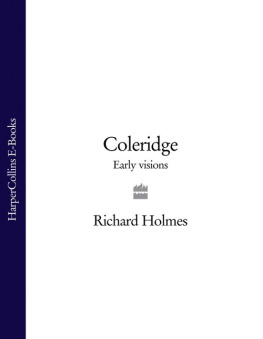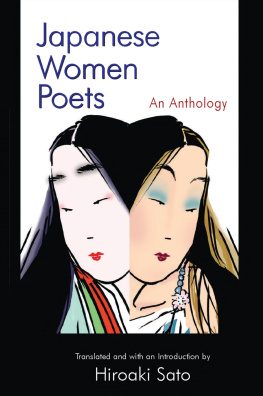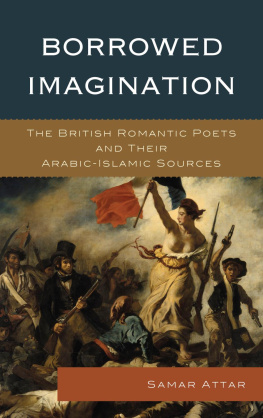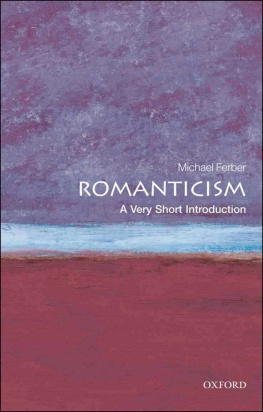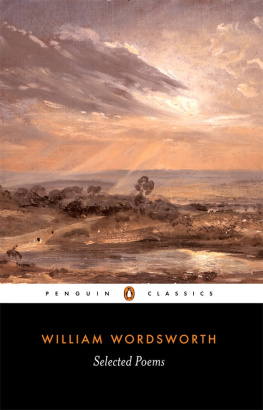
THE PENGUIN BOOK OF ROMANTIC POETRY
JONATHAN WORDSWORTH is descended from William Wordsworths younger brother, Christopher. He is Chairman of the Wordsworth Trust, Grasmere, retired Professor of English Literature at Oxford, and Fellow Emeritus of Exeter and St Catherines colleges. He has edited much of Wordsworths poetry, including the recent Penguin The Prelude: The Four Texts, and over 180 titles in the Woodstock Facsimile Series Revolution and Romanticism. He is the author of The Music of Humanity, The Borders of Vision, Ancestral Voices, Visionary Gleam and The Bright Work Grows.
JESSICA WORDSWORTH graduated from Mount Holyoke College, Massachusetts and took her Masters degree at Oxford. She is Administrator of the Wordsworth Winter School and Summer Conference at Grasmere, and is preparing the Penguin Selected Coleridge.
The Penguin Book of Romantic Poetry
Edited by
JONATHAN and JESSICA WORDSWORTH
PENGUIN BOOKS
PENGUIN BOOKS
Published by the Penguin Group
Penguin Books Ltd, 80 Strand, London WC2R 0RL, England
Penguin Group (USA) Inc., 375 Hudson Street, New York, New York 10014, USA
Penguin Group (Canada), 10 Alcorn Avenue, Toronto, Ontario, Canada M4V 3B2
(a division of Pearson Penguin Canada Inc.)
Penguin Ireland, 25 St Stephens Green, Dublin 2, Ireland
(a division of Penguin Books Ltd)
Penguin Group (Australia), 250 Camberwell Road, Camberwell, Victoria 3124, Australia
(a division of Pearson Australia Group Pty Ltd)
Penguin Books India Pvt Ltd, 11 Community Centre, Panchsheel Park, New Delhi 110 017, India
Penguin Group (NZ), cnr Airborne and Rosedale Roads, Albany, Auckland 1310, New Zealand
(a division of Pearson New Zealand Ltd)
Penguin Books (South Africa) (Pty) Ltd, 24 Sturdee Avenue, Rosebank 2196, South Africa
Penguin Books Ltd, Registered Offices: 80 Strand, London WC2R 0RL, England
www.penguin.com
This collection first published in hardback as The New Penguin Book of Romantic Poetry 2001
Published in paperback by Penguin Books 2003
Published under the current title in Penguin Classics 2005
Copyright Jonathan and Jessica Wordsworth, 2001
All rights reserved
The moral right of the author has been asserted
Except in the United States of America, this book is sold subject
to the condition that it shall not, by way of trade or otherwise, be lent,
re-sold, hired out, or otherwise circulated without the publishers
prior consent in any form of binding or cover other than that in
which it is published and without a similar condition including this
condition being imposed on the subsequent purchaser
EISBN: 9781101489406
For the twins, Helen Emily and Giles Philip
a child more than all other gifts Brings hope with it and forward looking thoughts
CONTENTS
PREFACE
Romanticism is the mood in which we recognize / A grandeur in the beatings of the heart, in which We feel that we are greater than we know (Wordsworth). It is a valuing of emotion, of imagination, a belief in human potential taken beyond its ordinary limits. It belongs to no period. Philip Sidney invoked it when he saw in his Elizabethan contemporaries a want of inward touch. Wallace Stevens evokes it in the 1940s as
the yes of the realist spoken because he must
Say yes, spoken because under every no
[Lies] a craving for yes that [has] never been broken.
There is every reason to think of Plato in certain moods as a Romantic. In Hazlitts words, it is a way of thinking as old as the heart of man.
Yet there are times when Romantic thinking, feeling, understanding are more likely. Something happens in the years following the French Revolution that is unique. Not that all writers suddenly became Romantic. The vast majority didnt either because their values remained those of an earlier period (Jane Austen, Crabbe, Peacock), or because they could not make the act of faith that is implied. Romanticism is an aspiring, a hopefulness an exalting, and exulting, of the imagination. For reasons that we associate with political hope roused, and defeated, in the Revolution, the spirit of the age seems for two generations after 1789 to have been especially favourable to this outgoing of imagination. But the Revolution was symptom as well as cause. Blake in 1784 (first Innocence poetry), Burns in his Kilmarnock Poems (1786), show that something was already in the air. Collins, MacPherson (Ossian), Chatterton, Barbauld, Cowper tempt us to think of quite a gradual late eighteenth-century moving into Romantic ways of thinking and writing. At the end of the period, similarly, we see in Hemans, Landon, Hood, Clare and Norton (all writing in the 1820s and early 1830s) a Victorianism before its time. In his eighty years (17701850) Wordsworth offers the completed cycle. Born in the early days of the reign of George III, he writes his first published poem, An Evening Walk, aged seventeen, in a mode that is clearly pre-Romantic. Yet he lives to be Victorias Poet Laureate.
If the Romantic period didnt begin or end conveniently, there are dates and happenings that present themselves as landmarks: Burns Poems 1786, Blakes Songs of Innocence (1789), Wollstonecrafts Vindication of the Rights of Woman (1792), Wordsworth and Coleridges Lyrical Ballads (1798) cluster about the Revolution, offering a suitably flexible sense of an opening, an outset. The deaths in succession of the second-generation Romantic poets Keats in 1821, Shelley in 1822, Byron in 1824 cannot fail to suggest a coming-to-an-end. The Reform Bill of 1832, though hardly a fulfilment of Romantic political ideals, is (to quote Byron) a point where the Fates change horses. Publication of Tennysons Poems Chiefly Lyrical in 1830, and Victorias Coronation, aged seventeen, in 1837, are clearly the start of something new.
With all this in mind, we have allowed ourselves flexibility in making selections for The New Penguin Book of Romantic Poetry. Cowper has been accepted as a forerunner of Romanticism, not because he was the best-selling English poet through much of the period, or because he is now wrongly unregarded, but that to leave him out would be to deny readers a means of testing what is and is not new. More extreme is the case of Anna Laetitia Barbauld, whose Unitarian poetry, published in 1773, a generation before Coleridge, just seemed to contain too much of the story of Romanticism to be omitted:
At this still hour the self-collected soul
Turns inward, and beholds a stranger there
Of high descent and more than mortal rank,
And embryo God, a spark of fire divine
(Summer Evenings Meditation)
At the other end of the period we have included few poets who were born after 1800, and none whose first publication was later than the 1820s.
Rather than presenting Romantic poetry writer by writer, offering a separate mini-selections of each, we have arranged the volume by theme, and to some extent by genre. The result has been to emphasize both likeness and difference. It is strange, but not unuseful, to think that Robinsons Sappho and Phaon, Wordsworths Ruined Cottage, Blakes Crystal Cabinet, Tighes Spenserian Psyche, Shelleys Alastor, Byrons Bride of Abydos and the Haidee episode of Don Juan are all Narratives of Love (Section II, below). How, one is led to ask, does romanticism with a small r relate to Romanticism with a big one? But there is the further bonus that comes from this principle of arrangement.
Next page

